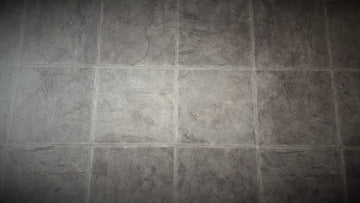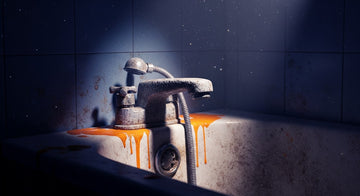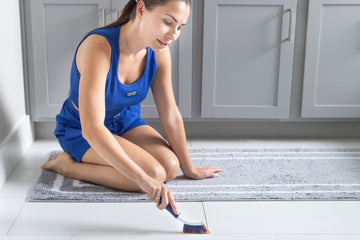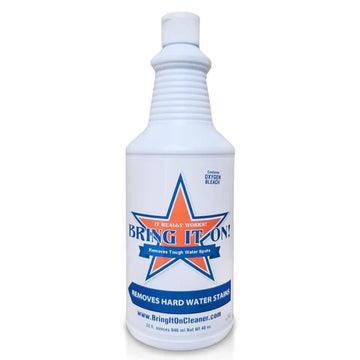It usually doesn't take a lot to clean linoleum floors, but we have to find the right cleaners if we want our floors to serve us for many years.
All-natural and eco-friendly
Linoleum is made from all-natural materials such as linseed oil, pine resin, ground cork dust, wood flour, and mineral fillers such as calcium carbonate, among others. Compared to vinyl flooring, which is made of synthetic material called polyvinyl chloride (PVC), linoleum is more eco-friendly and is non-allergenic, and thus highly-recommended for those with environmentally friendly mindset.
Yet, while linoleum can generally withstand most types of tear such as scratches, it is less durable than vinyl. It's for that reason that we need to take extra care of it.
How to take care of linoleum floors
Many of us find ourselves busy with a variety of everyday concerns that we can hardly maintain the cleanliness of our household, linoleum floors included. Here are simple hacks we can apply to prolong the high serviceability of these floors.
- Wipe up liquid spills immediately. Allowing liquid spill to sit for a long time and seep through the linoleum can loosen and detach it from its base. Tip? Use a soft absorbent rag or paper towels and wipe up the spill as soon as possible.
- Use water to clean the spill. Ensure that spill doesn't stain the floor by immediately rinsing the area with cool water. Allow it to dry completely with a microfiber cloth or towel before allowing any foot traffic. In case stain is inevitable, go for a deep cleaning method (see #5 below).
- Sweep loose dirt with a soft broom. Remove loose dirt before the build up as a stubborn dirt on the floor when mixed with other liquid substance like oil. This can result in the floor's dull and grimy appearance.
- Put doormats outside and rugs inside. Doormats and rugs help catch dirt and grit in the entrances before they can further soil the linoleum floors and scratch its finish. Make sure you have them in place.
-
Deep-clean with Bring It On Cleaner and Drill Pad. Deep clean is best for eliminating scuff marks and stubborn dirt that build up over time on linoleum floors. One of the most reliable and safest tools you can use (while attached to a drill) is a Bring It On Drill Pad.
- Wax the linoleum as often as necessary. After washing or deep-cleaning the linoleum, polishing the area is recommended not only to bring back its shine but to protect it from further scratches and damage. Make sure to buff the floor after letting each cost of wax thoroughly dry.
So look no further! For best results in cleaning your linoleum floors, buy Bring It On Drill Pads and Bring It On Cleaner. Then watch your home transform into a sparkly, squeaky clean space.
If you're worried about using commercial cleaners or you're just keen on going all-natural, we have some suggestions that will fit your needs. These homemade cleaners are easy to make, safe to use, and are just as effective in maintaining the longevity of your linoleum flooring.
DIY Linoleum Floor Cleaner:
Combining warm water with white vinegar and lemon essential oil is a powerful, all-natural linoleum cleaner. Just mix a gallon of warm water with a cup of white vinegar and a few drops of lemon essential oil. This mixture not only cleans your floor but also leaves a pleasant citrus scent.
Dealing with stubborn stains:
For stubborn stains like ink, paint, or tomato sauce, a paste of baking soda and water will do the trick. Apply the paste to the stain, let it sit for a few minutes, then gently scrub with a soft cloth. Rinse with water and dry thoroughly.
Preventive Measures:
Preventing damage is always easier than repairing it. Consider using furniture pads under the legs of tables, chairs, and other heavy furniture to prevent dents and scratches. If you have pets, keep their nails trimmed to avoid scratches.
FAQs:
Is it safe to use steam mops on linoleum floors?
Steam mops are generally not recommended for linoleum floors. The intense heat can cause the linoleum to warp or discolor. It's best to stick to gentle cleaning methods such as sweeping, mopping with mild cleaners, or using a vacuum cleaner designed for hard floors.
Can I use bleach on my linoleum floors?
Bleach is a powerful disinfectant, but it can also be too harsh for linoleum floors. It can discolor the flooring and break down its protective coating over time. Instead, opt for a milder cleaning solution, such as a mix of vinegar and water or a commercial cleaner specifically designed for linoleum.
How often should I wax my linoleum floor?
The frequency of waxing your linoleum floor depends on the foot traffic it receives. For areas with high traffic, waxing every 2-3 months is recommended. For lower traffic areas, you can get by with waxing just once or twice a year. Remember, waxing not only enhances the shine of your floor but also protects it from scratches and stains.





